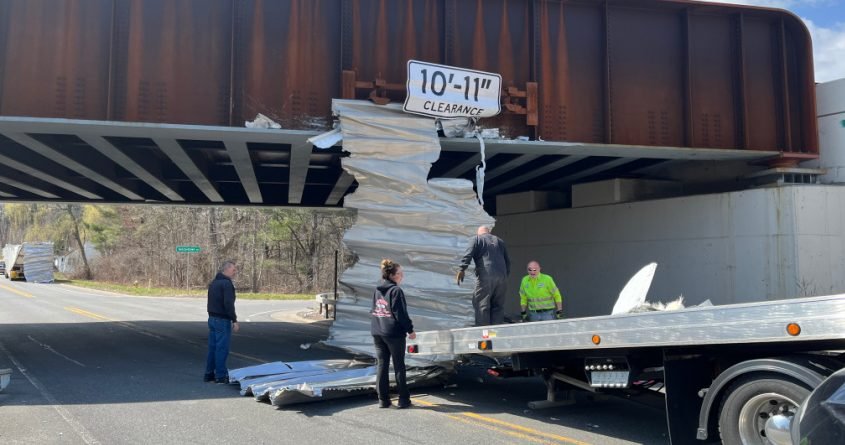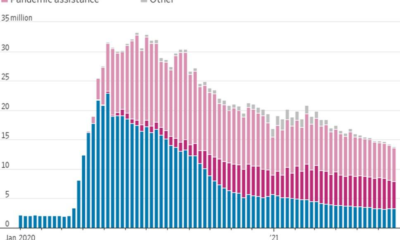Latest
Semi hits Glenridge Road bridge in Glenville in latest bridge strike, closes road for hours – The Daily Gazette – The Daily Gazette

GLENVILLE – Auto recovery crews worked a few hours Wednesday afternoon removing a tractor-trailer from Glenridge Road after it became the latest truck to strike the bridge.
The driver of the truck was not injured, but the semi’s trailer was mostly destroyed.
Glenville police and Canadian Pacific Railway Police responded to the scene just after 2 p.m. CP Railway owns the bridge.
CP Railway Police Officer Mike Tracy said the bridge was shut down to trains until the company could get someone to inspect it to make sure it was structurally sound.
Photos: Glenridge Road bridge strike Glenville 4/13/22 (9 Photos)
The top of the trailer was peeled completely off by the strike, leaving the trailer bent in the middle. The back doors of the truck were barely hanging on.
The truck was marked J.B. Hunt and was carrying products from Ace Hardware, said the driver, who declined to provide his name.
Police identified the man as 29-year-old Essa Sisoko of Ohio. He was issued a ticket for failing to obey the overhead clearance sign.
One piece of the trailer roof remained stuck to the bridge, just under the last sign announcing the bridge’s height, 10 feet, 11 inches.
The driver said he had turned off of Route 146, following the GPS directions in his truck.
“The truck GPS did not show anything ahead,” he said.
Top piece is really stuck. Attempt 2 to remove it under way https://t.co/6wRsVZ9kqi
— Shenandoah Briere (@SB_DailyGazette) April 13, 2022
He said there was also no noticeable sign to warn him of the bridge.
However, town officials have said there are a total of 14 signs prior to the bridge to warn drivers.
He became distracted when he took a call from his doctor via bluetooth and did not realize the mistake he had made until he was already under the bridge.
“I could feel something bad happen,” he said.
They had to cut parts of the semi that hit the Glenridge Road Bridge this afternoon and remove the products inside before towing it. @dgazette pic.twitter.com/jfgY9ThS60
— Shenandoah Briere (@SB_DailyGazette) April 13, 2022
If it wasn’t for a smaller load the truck would’ve gotten stuck, he said.
He said he has been driving trucks for two years and on this journey, he was on his way to Ohio.
“I’m out of a job now,” he said.
Workers had to cut up parts of the truck to tow it away. They also had to remove all the products inside. Those products, like pressure cookers, hand saws and drills will be stored by AC Towing until the insurance company collects them, said Karen Caprara with AC Towing. The road was expected to be shut down for several hours as a result. ACs Towing and Recovery and Liggett’s Auto & Towing conducted the removal.
The state Department of Transportation just last month presented the latest plan to mitigate strikes at the Glenville bridge.
The plan calls for a turnaround ahead of the bridge in the westbound direction to be installed this year, and an overheight vehicle detection system for 2023.
Photos: Glenridge Road bridge strike Glenville 4/13/22 (9 Photos)
DOT officials presented the schedule and concept to the Glenville town board after years of calls by town and state officials, as well as residents, for something to be done to keep trucks from hitting the bridge, which only has a clearance height of 10 feet 11 inches.
But scenes such as Wednesday’s have become almost commonplace at the bridge. More than 100 vehicles have crashed into the bridge in recent years, including a semi in January, just 17 days into the new year.
“It’s shocking that we suffer another bridge strike; one of the worst I’ve seen,” Glenville Supervisor Chris Koetzle said Wednesday afternoon. “Again, thankfully nobody was hurt, but this is a stark reminder that we need to proceed with the deployment of DOT’s proposed solutions immediately.”
The driver said more signs closer to the bridge need to be put in place so this doesn’t happen to anyone else.
It’s kinda surprising that Goggle Maps can warn you of traffic delays, and speed traps, but can’t seem to warn about bridges that might be problematic for trucks, many that have been there for many decades. He may not have been going by GM, but whatever he’s using for guidance.
Latest
A drug company abandoned a treatment for ‘bubble boy disease.’ After a 5-year fight, this little girl is about to get it

Later this spring, a little girl in California who essentially has no immune system will receive a lifesaving treatment for “bubble boy disease” thanks to the persistence of a dogged group of parents, a pediatrician, a veteran newsman and a few episodes of “Grey’s Anatomy.”
Five-year-old Seersha Sulack has the same rare disease portrayed in the 1976 John Travolta movie, “The Boy in the Plastic Bubble.” A germ – even a common cold – could kill her, and so she stays away from anyone outside her immediate family.
The treatment she’s been waiting for had stunning, near-perfect results in a clinical trial, but it’s been sitting on the shelf for years in the US because the pharmaceutical company that once owned the license abandoned it when it decided not to not to pursue approval from the US Food and Drug Administration.
“It’s a pretty tough situation,” said Dr. P.J. Brooks, acting director of the Division of Rare Diseases Research Innovation at the National Institute of Health’s National Center for Advancing Translational Sciences. “You have an effective therapy like (this one) and people can’t get access to it.”
Seersha is expected to get the treatment next month. She’ll become only the second child in the US in the past five years to receive it; the first child received it earlier this month.
The treatment is for a particular type of severe combined immunodeficiency called ADA-SCID that’s extremely rare – in the US, eight babies a year are born with it. Currently, 26 children in the US and Canada are on the waiting list to get the therapy, according to Dr. Donald Kohn, a UCLA scientist who has been working on the treatment for nearly 40 years.
The treatment is a type of gene therapy: Doctors will give Seersha a normal copy of the defective gene that disabled Seersha’s immune system.
Gene therapies hold great hope for all sorts of diseases, but they’re very expensive to develop, and pharmaceutical companies can’t be sure that they’ll make a profit because health insurance companies haven’t always agreed to pay the multi-million dollar price tags.
“It has not escaped our attention at FDA that there have been some clouds on the horizon in gene therapy,” Dr. Peter Marks, head of the US Food and Drug Administration’s Center for Biologics Evaluation and Research, said at a biotech conference in California in October. “We really want to try to see what we can do to move things forward.”
The gene therapy Seersha’s been waiting for was once called OTL-101, for Orchard Therapeutics Limited. Orchard launched in 2016 with OTL-101 as its “lead candidate,” but four years later, the company announced it would “reduce investment” in the therapy and prioritize treatments for more common conditions.
“A lot of us were upset and angry,” said Seersha’s mother, Shayla Sulack, noting that OTL-101 was developed with millions of dollars in state and federal government aid.
“We were always, ‘it’s going to happen, it’s going to happen,’ ” she added. Then, after Orchard decided not to pursue the therapy, “a bunch of us SCID moms were like, ‘Excuse me?’ ”
In a statement to CNN, an Orchard spokesperson wrote that “after encountering technical challenges related to the commercial-grade manufacture of this particular therapy, we made the very difficult decision to limit additional investment in [the SCID gene therapy].” The spokesperson spoke on the condition of anonymity.
A mother’s ‘oh, crap’ moment
Shayla and her husband, Stephen Sulack IV, were high school sweethearts at Tehachapi High School, about 100 miles north of Los Angeles. In 2010, when she was 18 and he was 19, they married at the Little White Wedding Chapel in Las Vegas.
Stephen was in the Army, and over the next few years, the young couple moved to various military bases. Their daughter Skylar was born in 2012 and son Stephen V in 2014.
In 2017, the family moved to Hawaii for Stephen’s new post as a Black Hawk helicopter pilot at Schofield Barracks in Oahu. Two weeks later, Seersha was born at Tripler Army Medical Center in Honolulu.
Weighing 6 pounds and 10 ounces, Seersha appeared perfectly healthy, and her parents took her on family outings, going to Dole Plantation and Waikiki Beach when she was five days old.
Strolling around the shops near the beach that day, the family went into a Tesla dealership just for fun. While sitting in a showroom car, Shayla got a phone call from a number she didn’t recognize.
It was a geneticist at Tripler. He told Shayla that a routine blood test, a prick on a newborn’s heel done in nearly every state, showed Seersha’s level of T cells – a type of white blood cell crucial to fighting off infections – was just five. Normal T cell levels for newborns are around 3,000.
This meant any infection, no matter how small, could kill Seersha. The geneticist said to bring her back to the hospital at Tripler immediately.
Shayla says her first reaction was: “Oh, crap.”
Not only had they been going everywhere with their new baby, but Seersha’s big brother and sister had been affectionately pawing all over her.
Shayla and Stephen left the Tesla dealership and made the 20-minute drive to the hospital while Shayla’s parents took the older two children home in their car.
At Tripler, doctors explained more about SCID, and a psychologist was on hand to help the Sulacks deal with the shocking news.
Only about one baby a year is born with the SCID in Hawaii, according to Sylvia Mann, genetics coordinator at the state’s department of health.
The next day, Shayla and Seersha were on a military medical transport flight to Los Angeles. Seersha was in an incubator in the front of the plane, and the other patients were kept in the back to decrease the chances they could get her sick.
An ambulance drove Shayla and Seersha to UCLA Mattel Children’s Hospital, one of 47 medical centers in the US and Canada that specialize in SCID as members of the Primary Immune Deficiency Treatment Consortium funded by the National Institutes of Health.
Once there, doctors laid out the options for saving Seersha’s life.
Options for Seersha
It turned out none of them were very good.
ADA-SCID is treated with regular injections to replace a missing enzyme that helps with immune function. They help a great deal, but they don’t give the child a full immune system, and their effectiveness can wane over time.
The UCLA doctors laid out two longer-term options. Seersha could receive a stem cell transplant, which is lifesaving and the standard treatment for SCID. Doctors would test her mother, father, brother, and sister and determine the best genetic match, and then would extract cells that specialize in forming blood cells and give them to Seersha.
Testing showed that any of her family members could donate to her, but none of them was a particularly good match. This was bad news for two reasons: One, the transplant likely wouldn’t be as effective. Two, Seersha would be more likely to suffer complications.
Latest
Youssef Ramadan earns ACC Men’s Swimmer of the Year

After his historical season, Youssef Ramadan took the ACC Men’s Swimmer of the Year title for the 2022-23 season, the league announced Monday afternoon.
Ramadan became the first-ever national champion in program history, swimming the second-fastest 100 fly time in NCAA history at 43.15. He earned five All-American awards and two honorable mentions at NCAA’s.
Ramadan was named male MVP at ACC’s in February for the second year in a row, on top of two gold medals and two silver medals. He also took ACC Male Swimmer of the Week twice earlier in the season.
Throughout the 2022-23 season, he’s broken four individual school records and two relay records.
Latest
Changes on tap for Americans who hunt waterfowl in Manitoba

Americans planning to hunt waterfowl this fall in Manitoba will be able to draw a seven-day license but must enter a lottery for a limited number of “foreign resident” licenses in subsequent years if they don’t book their trip through an outfitter, under new waterfowl regulations the province announced earlier this month.
“As part of the initial phase-in strategy for fall of 2023, Manitoba is ensuring that all applicants for the draw will receive a seven-day Foreign Resident Migratory Game Bird License,” Manitoba’s Ministry of Natural Resources and Northern Development said on its website. “In subsequent years the allocations for each license type will be determined based on license sales, hunter questionnaire data from all user groups and stakeholder input. The combination of the seven-day license and associated draw for freelance foreign resident hunters is intended to discourage visiting hunters from creating lasting systems of control that inhibit other hunters.”
The new regulations are a key component of the Waterfowl Hunting Modernization Project, a proposal the Manitoba government unveiled last fall before a 45-day comment period that ended Friday, Oct. 7.
American hunters will now have the opportunity to access the following Manitoba waterfowl and upland game bird licenses, the province said:
Foreign Resident Upland Game Bird License: Required to hunt upland birds and can be purchased online and is subject to the same regulatory framework as resident hunters.
Foreign Resident Migratory Game Bird License: Required to hunt migratory birds and is a seven-day license, which can be accessed either by entering a draw process or booking with a licensed outfitter.
Foreign Resident Legacy Migratory Game Bird License: A grandfathered opportunity for qualifying foreign resident landowners or lessees of Crown land.
To qualify for the special grandfathered provisions, Americans (and other foreign residents) must have owned property in Manitoba before Sept. 1, 2022, and still own that property; be a shareholder of a corporation owning registered property in Manitoba; or be a crown land lessee. Eligible land interest holders must also have hunted waterfowl in Manitoba during the previous five years between 2018 and 2022 to qualify for the legacy license.
-

 Business3 years ago
Business3 years agoHyundai Leads Industry in U.S. News & World Report 2023 Best Cars for the Money Awards
-

 Innovation3 years ago
Innovation3 years agoJay-S ventures into the urban genre with “Bailar en la Playa” his latest production
-

 Business3 years ago
Business3 years agoThree Questions Small Business Owners Should Ask In Creating A Workplace Culture – Forbes
-

 Business3 years ago
Business3 years agoA Fintech Makes It Easy For Small Businesses To Offer 401(k) Retirement Benefits – Forbes
-

 Business3 years ago
Business3 years agoBritain’s Small Businesses See Better Times Ahead But Is Their Optimism Justified? – Forbes
-

 Money3 years ago
Money3 years agoCharlie Crist leads Democratic gubernatorial field again in money chase – Florida Politics
-

 Money3 years ago
Money3 years agoTesting New Tools for Horizon Worlds Creators To Earn Money
-

 Business3 years ago
Business3 years agoSmall Business Labor Shortage – Forbes

